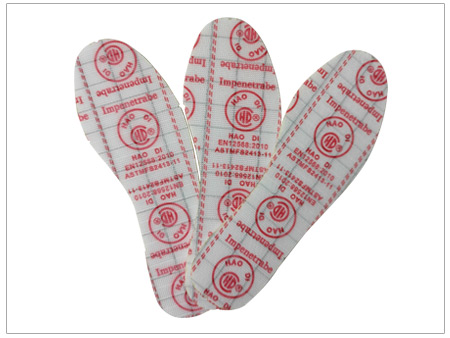Click:Release date:2023/10/17
All kinds of shoes use different soles. Many customers don't know what kind of soles to choose when buying safety shoes. In order to facilitate ordinary customers to buy safety shoes, the technicians of Dongfang Shuo safety shoes production technology department roughly sorted out the types of soles during the working interval, hoping to provide corresponding help for everyone to buy safety shoes!
1、 Outsole
1. The material of outsole is simply natural rubber or synthetic rubber.
(1) Natural rubber: the advantage of natural rubber is that it is very soft, elastic and good, and can be suitable for all kinds of sports, but the disadvantage is also obvious, that is, it is not wear-resistant. Indoor sports shoes are mostly made of natural rubber.
2. Synthetic rubber is divided into wear-resistant rubber, environmental protection rubber, air rubber, viscous rubber, hard rubber and carbon rubber.
(1) Wear resistant rubber: the wear resistance and toughness of wear-resistant rubber are very good, so it is very durable. This rubber material is generally used on the outsole of tennis shoes.
(2) Environmentally friendly rubber: also known as recycled rubber, this rubber outsole contains up to 10% of recycled rubber, mainly for the purpose of environmental protection.
(3) Air rubber: the rubber contains air and has a certain shock absorption function, but it is not very wear-resistant and is not widely used.
(4) Sticky rubber: sticky rubber is characterized by good flexibility and anti slip. It is generally used on indoor sports shoes.
(5) Hard rubber: hard rubber is the most comprehensive rubber in the outsole rubber material. It is tough, non slip and very wear-resistant. Naturally, it is widely used. Most multifunctional shoes and basketball shoes use this kind of rubber as the outsole.
(6) Carbon rubber: carbon is added to ordinary rubber materials to make the rubber more tough and wear-resistant. Most running shoes use this kind of rubber, and BRS letters will be left on the back of the sole of the running shoes to indicate that carbon rubber is used on the outsole.
3. Gluing outsole: this kind of outsole is not common. The raw material of this kind of outsole is industrial glue, which is stirred by a mixer and then heated into a mold. It is characterized by softness and very anti-skid.
2、 Midsole
1. Now I think many people will know about the midsole of sneakers, that is, Phylon midsole and EVA midsole are the most common. In fact, both kinds of midsole belong to the same attribute category (engineering plastics), but why are there different names? Phylon originated in the United States. The earliest shoe midsole was called Phylon, and there was no distinction between EVA midsole and Phylon midsole. Later, with the continuous development of footwear products, taking some large brand footwear product R & D factories in Taiwan and South Korea as the source, we divided the name of the midsole more systematically, and then we have what we now call EVA midsole. Now let me talk about the difference between EVA midsole and Phylon midsole.
Nowadays, the most commonly used insole in shoes is Phylon, which is characterized by portability, good elasticity and good cushioning performance. Phylon is called secondary foaming. EVA midsole is also very light, but the cushioning performance and elasticity are far less than Phylon midsole, and the cost is much lower than Phylon midsole. EVA midsole is called one-time foaming. The reason why they have the same properties, different names and different properties is that Phylon is a secondary foaming, while EVA is a primary foaming.
(1) One time foaming: the shoe midsole formed by injecting materials into the mold and heating at high temperature is called one-time foaming midsole, that is, EVA shoe midsole.
(2) Secondary foaming: after the material is injected into the mold, the shoe midsole is fired and molded after two times of high temperature heating, which is called secondary foaming midsole, which is often referred to as Phylon midsole. The softness and hardness of Phylon are also controlled by temperature. In the process of firing Phylon midsole, the higher the temperature, the greater the density and hardness of the fired Phylon. The smaller the heat, the lighter and softer the naturally burned Phylon, so the evaluation of the midsole cannot be measured by weight or the degree of softness.
(3) Cloth wrapped insole: cloth wrapped insole is also a Phylon insole, which is just a shoemaking technology used by designers to pursue the overall design feeling. The best example is that the same fabric is used for the insole and the body of the shoe, which makes the overall combination of the body and the sole of the shoe, and is also a bright spot in the manufacturing process of this shoe. To realize this process is to wrap the formed Phylon midsole with the selected cloth and burn it in the mold at high temperature, which turns into the shoe midsole with cloth texture like Lb1 we see.
2. Pu midsole: in addition to Phylon midsole and EVA midsole, Pu midsole is also very common. The biggest advantage of Pu midsole is its good elasticity and toughness.
3. Bag midsole: now many sneakers use a built-in midsole structure, also known as bag midsole. Like the familiar T-Mac series, Nike's style series belongs to the package midsole structure. The package midsole is composed of two parts: the outsole and the upper from the appearance, but the structure is also composed of three parts: the outsole, the midsole and the upper, but the midsole is wrapped inside the upper.
3、 Insole and integrated sole
1. Insole: insole can also be regarded as a form of bag midsole. Different from bag midsole, the insole structure is the sole wrapped in the outsole. For example, Force1, even if it is an insole structure, it is not like the overall rubber outsole as seen from the appearance. In fact, the inner side of the rubber outsole is wrapped with a shoe midsole. This kind of midsole is also called MD midsole, which belongs to EVA one-time foaming.
2. One piece sole:
(1) The most common one-piece sole is eva one-time foaming sole. This kind of sole is low in cost and poor in skid resistance. When the sole is stained with water, it is like wearing roller skates. Reebok's 3D sole is the best "spokesperson" of this EVA one-time foaming sole.
(3) PU sole: ADI and Nike don't use this kind of sole very much. PU sole belongs to low-temperature forming sole. Pu bottom is characterized by portability, but it should not be exposed to water. Chemical reaction will occur when encountering water, and it will corrode layer by layer.
(4) Pure rubber sole: pure rubber sole is mostly used for outdoor hiking shoes, or work shoes, electrical shoes. The whole sole is made of rubber, which has the advantage of wear resistance and skid resistance, but the disadvantage is that it weighs too much. Cat work shoes generally use this sole, also known as insulating sole.




